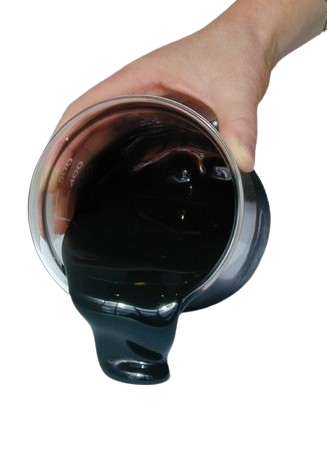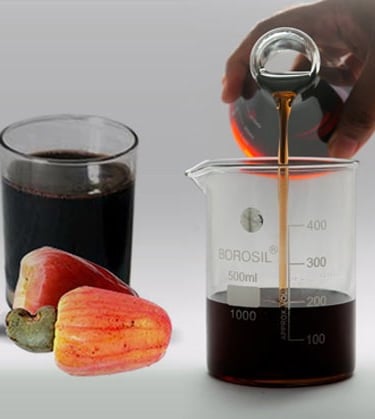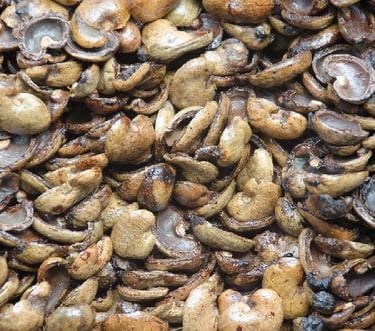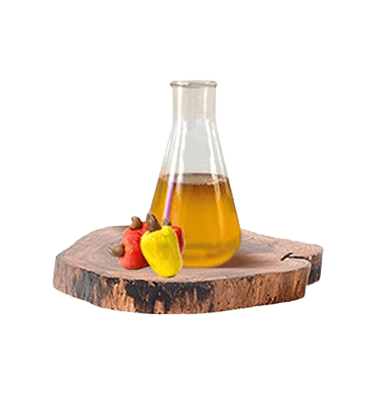KGA Enterprises - CNSL Derivatives, Cardanol, Resins and Other Eco-chemical products
Binding Power. Friction Control. Naturally.
Cardanol Residue is a dense, viscous by-product obtained during the vacuum distillation of Cashew Nut Shell Liquid (CNSL) for the extraction of high-purity Cardanol. Though lower in monomeric cardanol content, this residue retains significant quantities of oligomerized phenolic compounds, unsaturated hydrocarbons, and polymeric structures, offering broad utility across multiple industrial sectors.
Cardanol Residue:A By-Product with Industrial Potential


What is Cardanol Residue?
A by-product of the Cashew Industry
Cardanol Residue is the bottom fraction left after the distillation or vacuum separation of Cardanol oil from Cashew Nut Shell Liquid (CNSL). It is a complex, viscous material comprising:
Unreacted high-boiling phenolic compounds, Polymeric cardols and cardanols, Alkenyl-substituted phenols and residual hydrocarbons
While often overshadowed by pure cardanol, this residue is chemically rich, thermally stable, and industrially valuable.
Why Cardanol Residue?
Blended with resins or solvents
Used as a base modifier or extender
Pre-reacted with hardeners in resin formulations
Integration into Formulations
Custom Modifications (R&D Opportunity)
Maleated Cardanol Residue → compatibilizer in plastics
Epoxidized Cardanol Residue → reactive diluent for epoxy systems
Sulfonated Derivatives → emulsifiers or dispersants
Phosphate Esters → fire retardant coatings & polyols
Cardanol Residue can be directly introduced into manufacturing streams:
Cardanol residue can be upgraded into functional materials:
Molecular Composition & Structural Insights
Cardanol residue exhibits high reactivity due to the presence of aromatic rings with electron-donating hydroxyl (–OH) groups, which readily participate in condensation polymerization reactions. This reactivity makes it a valuable modifier or partial substitute in thermosetting resin systems.
It is chemically compatible with a wide range of industrial polymers, including phenol-formaldehyde and urea-formaldehyde resins, where it improves toughness and moisture resistance. When suitably modified, it also blends well with alkyds, epoxy resins, and polyurethanes, enhancing flexibility and reducing brittleness. Additionally, its resinous structure enables effective integration with elastomers and asphaltic binders, making it a versatile component in rubber and road construction formulations.
Specifications
High Reactivity
Polymerized Cardanol 25–35%
Cardol 20–30%
Resinous Compounds 30–45%
Anacardic Acid (trace) <5%
Moisture <1%
Chemical Composition
Cardanol Properties
Thermal Stability
High Viscosity
Strong Bonding Ability
Water Resistance
Viscosity: ~5000 – 8000 cP (depending on temperature)
Flash Point: > 200°C, making it stable for high-temperature applications
Solubility: Insoluble in water, soluble in organic solvents
Appearance: Dark brown to black viscous liquid
Density: 0.94 – 0.97 g/cm³
Applications
Bitumen & Asphalt Modification
In the construction industry, Cardanol Residue is used as a plasticizer and modifier in bitumen and asphalt formulations. When blended with hot mix asphalt (HMA) or polymer-modified bitumen (PMB), it improves the flexibility, adhesion to aggregates, and resistance to cracking. It also enhances the long-term durability of road surfaces and provides improved performance in cold weather conditions.
Friction Materials
(Brake Linings, Clutch Facings, Disc Pads)
Cardanol Residue is widely used as a binder and filler in the manufacture of friction materials. Its high thermal stability and adhesive properties make it suitable for use in automotive and industrial brake linings, clutch systems, and disc pads. The residue contributes to the material’s thermal resistance, wear resistance, and damping characteristics, which are crucial for high-performance automotive systems.
Fuel Additive & Renewable Energy
Cardanol Residue can be used as a fuel extender in furnace oils and biomass-based energy systems. It helps to increase the calorific value of fuels while maintaining combustion efficiency. Its use in biofuels can reduce dependence on traditional fossil fuels, contributing to more sustainable energy solutions.
Polymer and Resin Formulations
Cardanol Residue is used as a reactive diluent or resin extender in the production of phenolic resins, epoxy systems, and other thermoset polymers. It contributes to flexibility, impact resistance, and thermal stability in the final product.
Paints, Coatings, and Inks
Wood and Laminate Products
In the coatings industry, Cardanol Residue acts as a low-cost extender and binder for industrial paints, primers, and inks. It is particularly valuable in protective coatings for metal surfaces due to its film-forming properties, chemical resistance, and ability to enhance adhesion. This makes it a popular choice in applications requiring durable, corrosion-resistant finishes.
Cardanol Residue serves as an adhesive binder in engineered wood products like particle board and medium-density fiberboard (MDF). It enhances the dimensional stability and moisture resistance of wood panels while providing an environmentally friendly, bio-based alternative to traditional phenolic resins. It is also used in decorative laminates, offering improved bonding strength.
Customized Specifications
We offer tailor-made variants of Cardanol Residue based on your specifications:
10000 MT
Our Production Capacity
Adjusted viscosity
Enhanced flash point
Blended formulations for specific use-cases (e.g., road, rubber, resin, fuel)
Whether you're in coatings, foundry, automotive, construction, or green energy, we’ll help you get the right blend for your process.
High-quality CNCL derivatives, cardanol, resins, and other essential chemical products.
our Products
+91-991 270 0077
© 2025. KGA Enterprises. All rights reserved.
GSTIN: 06AGMPR7624P2ZI
Regd Office: GTM Colony, Hisar Road, Sirsa - 125055 (Haryana)
Factory: VPO Theri Baba Sawan Singh, Distt. Sirsa - 125060 (Haryana)


Contact
Quick links
sales@kgaenterprises.com
+91-991 280 0077
Cashew Husk








